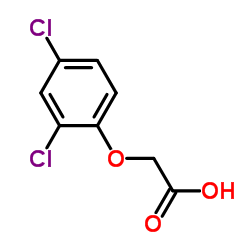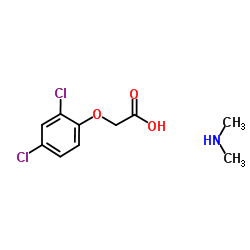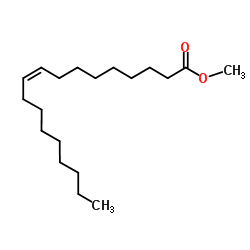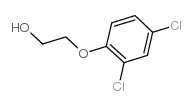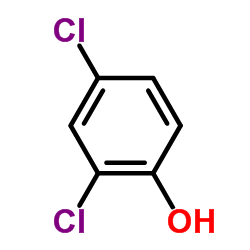Methyl (2,4-dichlorophenoxy)acetate
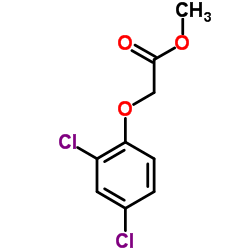
Methyl (2,4-dichlorophenoxy)acetate structure
|
Common Name | Methyl (2,4-dichlorophenoxy)acetate | ||
|---|---|---|---|---|
| CAS Number | 1928-38-7 | Molecular Weight | 235.064 | |
| Density | 1.4±0.1 g/cm3 | Boiling Point | 298.3±25.0 °C at 760 mmHg | |
| Molecular Formula | C9H8Cl2O3 | Melting Point | 119°C(lit.) | |
| MSDS | Chinese USA | Flash Point | 124.1±22.2 °C | |
| Symbol |


GHS07, GHS09 |
Signal Word | Warning | |
| Name | 2,4-D-methyl |
|---|---|
| Synonym | More Synonyms |
| Density | 1.4±0.1 g/cm3 |
|---|---|
| Boiling Point | 298.3±25.0 °C at 760 mmHg |
| Melting Point | 119°C(lit.) |
| Molecular Formula | C9H8Cl2O3 |
| Molecular Weight | 235.064 |
| Flash Point | 124.1±22.2 °C |
| Exact Mass | 233.985046 |
| PSA | 35.53000 |
| LogP | 2.65 |
| Vapour Pressure | 0.0±0.6 mmHg at 25°C |
| Index of Refraction | 1.531 |
| Storage condition | 0-6°C |
CHEMICAL IDENTIFICATION
HEALTH HAZARD DATAACUTE TOXICITY DATA
|
| Symbol |


GHS07, GHS09 |
|---|---|
| Signal Word | Warning |
| Hazard Statements | H302-H317-H410 |
| Precautionary Statements | P280-P301 + P312 + P330 |
| Personal Protective Equipment | dust mask type N95 (US);Eyeshields;Faceshields;Gloves |
| Hazard Codes | F,Xn,N |
| Risk Phrases | 11-38-48/20-51/53-62-65-67-50/53-43-22 |
| Safety Phrases | S61-S62-S60-S46-S36/37-S29-S26 |
| RIDADR | 3345 |
| RTECS | AG8810000 |
| Packaging Group | III |
| Hazard Class | 6.1(b) |
| HS Code | 2918990090 |
|
~99% 
Methyl (2,4-dic... CAS#:1928-38-7 |
| Literature: Lin; Que Hee Archives of Environmental Contamination and Toxicology, 1999 , vol. 36, # 4 p. 485 - 489 |
|
~% 
Methyl (2,4-dic... CAS#:1928-38-7 |
| Literature: US2007/184980 A1, ; Page/Page column 2-3 ; |
|
~14% 
Methyl (2,4-dic... CAS#:1928-38-7 |
| Literature: Synthesis, , # 9 art. no. M12811SS, p. 1375 - 1382 |
|
~% 
Methyl (2,4-dic... CAS#:1928-38-7 |
| Literature: Journal of the American Chemical Society, , vol. 69, p. 718,721 |
|
~91% 
Methyl (2,4-dic... CAS#:1928-38-7 |
| Literature: Chatfield; Croft; Dang; Murby; Yu; Wells Analytical Chemistry, 1995 , vol. 67, # 5 p. 945 - 951 |
|
~% 
Methyl (2,4-dic... CAS#:1928-38-7 |
| Literature: Journal of Chemical Research, , # 7 p. 432 - 433 |
| HS Code | 2918990090 |
|---|---|
| Summary | 2918990090. other carboxylic acids with additional oxygen function and their anhydrides, halides, peroxides and peroxyacids; their halogenated, sulphonated, nitrated or nitrosated derivatives. VAT:17.0%. Tax rebate rate:13.0%. . MFN tariff:6.5%. General tariff:30.0% |
|
Quantitative assessment of the effects of metals on microbial degradation of organic chemicals.
Appl. Environ. Microbiol. 57(5) , 1498-503, (1991) Biodegradation inhibition of a benchmark chemical, 2,4-dichloro-phenoxyacetic acid methyl ester (2,4-DME), was used to quantify the inhibitory effects of heavy metals on aerobic microbial degradation ... |
|
|
Development of an analytical scheme for simazine and 2,4-D in soil and water runoff from ornamental plant nursery plots.
J. Agric. Food Chem. 51(1) , 14-20, (2003) The transport and fate of pesticides applied to ornamental plant nursery crops are not well documented. Methodology for analysis of soil and water runoff samples concomitantly containing the herbicide... |
|
|
Mesenchymal stem cells derived from human gingiva are capable of immunomodulatory functions and ameliorate inflammation-related tissue destruction in experimental colitis.
J. Immunol. 183(12) , 7787-98, (2009) Aside from the well-established self-renewal and multipotent differentiation properties, mesenchymal stem cells exhibit both immunomodulatory and anti-inflammatory roles in several experimental autoim... |
| MFCD00018356 |
| Acetic acid, 2-(2,4-dichlorophenoxy)-, methyl ester |
| 2,4-dichlorophenoxyacetic acid methyl ester |
| Methyl (2,4-dichlorophenoxy)acetate |
| methyl 2-(2,4-dichlorophenoxy)acetate |
| Acetic acid, (2,4-dichlorophenoxy)-, methyl ester |
| methyl 2,4-dichlorophenoxyacetate |
| EINECS 217-670-7 |

